Catholic Customs
 |
 |
 |
 |
 |
 |
 |
Ringing the Bells for All Saints Day

A medieval bell tower in Portugal

Nature lends her help to create
the ambience for the holy day
"Was it not the special joy of everyone and the honor of Christian families? Taking a holy pride in the persons whose virtues they handed down to posterity, they considered the heavenly glory of their ancestors, who had perhaps been unknown in the world, to be a higher nobility than any earthly dignity." (1)
Indeed it would seem that nature shows forth the truth recalled at this great feast: "At this season, when cold and darkness prevail, nature itself, stripping off its last adornments, seems to be preparing the world for the last passage of the human race into the heavenly country." (2)
Saints Day bread
After the solemn Mass, housewives in every land served their finest sweet breads as a tribute to the Saints.
The breads were called Mindszenti Kalacska in Hungary, Strucel Swiateczne in Poland and Pane Co' Santi (All Saints bread) in Italy. In some areas of Austria, Himmelsleiter were baked to resemble ladders reaching towards Heaven. (3) In Burgenland and Lower Austria, round cakes called "All Saints' Day Wreaths" were baked and hung on the front door to give a festive welcome to the feast.
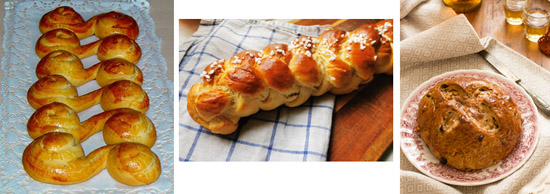
Special All Saints Day bread: Allheiger Spitzl from Germany,
Himmelsleiter from Austria & Pane Co' Santi from Italy.
Decorating graves
Catholics of old not only rejoiced in the heavenly glory of their blessed ancestors, but also contemplated those ancestors separated from this glory by the flames of purification. After enjoying the festive food at home, Catholics in every land journeyed to the cemeteries to prepare for the upcoming feast.

Candlelit cemeteries in the Czech Republic & Slovakia
Every effort was made to create beautiful adornments for the graves. The women in the Alpine villages wove wreaths of evergreens and wild flowers to lay on the graves. In many northern and central European countries, candles (referred to as "lights of the Holy Souls") were also laid on the graves.
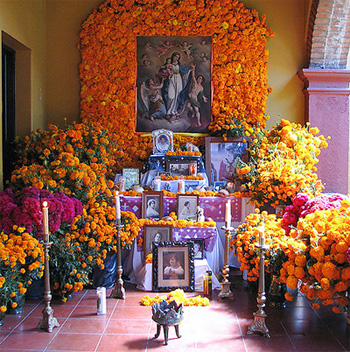
Mexican altar for the dead
Such was the devotion for the Holy Souls that even abandoned graves received special attention. In some places, it was customary to light bonfires for the forgotten dead and to toll the bells constantly.
Hungarian villages arranged for the abandoned graves to be cleaned and adorned by a different family from the village each year. (5) In the German town of St. Nikola, the villagers who had died of drowning were commemorated with a wreath that was sent floating down the river.
In Mexico devotion to the faithful departed is so strong that they developed the custom of setting up special altars (ofrendas) in their homes during the Days of the Dead (October 31-November 2). The altars often have at least three tiers with images of Patron Saints, family members, skulls, bread, salt, water, marigolds and one candle for every deceased family member. One extra candle was also lighted for any forgotten dead. (6)
Tolling of the bells
As darkness covered the earth on this joyous Day of Saints, the thoughts of all turned toward their beloved dead. Housewives throughout Europe baked their traditional recipes for the “Bread of the Dead.”
The Polish bread was a long loaf called zaduszki that resemble da dead body. In Székely, Hungary, the bread was known as "God's pie," and the Mexican Pan de Muerto contained a small skeleton hidden inside. In Belgium, the bread was formed into little cakes, and each person was expected to eat a small cake for each deceased family member. (7)
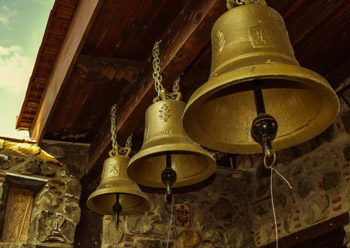
At the sound of the bells on All Souls Day, the people lit their Candlemas candle
In Brittany, eight men were chosen in each village to fulfill this duty. At dark, four of the men took turns tolling the church bell for an entire hour. During this hour, the four remaining men rang hand bells as they went from house to house throughout the entire countryside. On approaching a house, the men solemnly chanted: "Christians awake, pray to God for the souls of the dead, and say the Pater and Ave for them." To this the family replied, "Amen."
At the sound of the bells, the people extinguished all the candles in their house and lit their blessed Candlemas candle. The family then knelt down to pray the Rosary led by the men. (9) The deep solemnity of the prayers left everyone thinking on the dead and contemplating what those suffering souls were experiencing.
Preparing for the Souls' visit
In many countries of the Old World, there was a widespread belief that on certain evenings of Hallowtide (All Hallow's Eve and the evening of All Saints Day) the souls were released from Purgatory to return to their earthly homes to rest for a short time and receive relief from the prayers and charitable acts of the living.

All Souls Day: the link between the living & the dead
The tolling of the church bells was seen as a sign of either the arrival or the departure of the souls who were said to come to earth at the sound of the Vesper bells on the eve of All Hallows and All Souls Days.
Opinions varied on the length of the souls' stay on earth. The Hungarians believed that the departed souls attended Mass in the evening of All Saints' Day; when the evening church bells tolled, the Mass ended and the souls traveled to the former earthly homes.
In many Catholic countries, families set out plates of food and drinks to welcome those visiting souls. In some places (Poland and Brittany in particular), extra plates were set at the evening meal, which was eaten in a respectful silence.
The Poles began the meal in a striking manner. The head of the house called upon the souls of the dead to join them by opening a door or window, saying:
Holy sainted ancestors, we beg you
Come, fly to us
To eat and drink
Whatever I can offer you
Welcome to whatever this hut can afford
Sainted ancestors, we beg you
Come, fly to us. (11)
Food was served first onto the plates reserved for the dead. No one was permitted to touch these portions until after the meal when they were distributed to the poor.
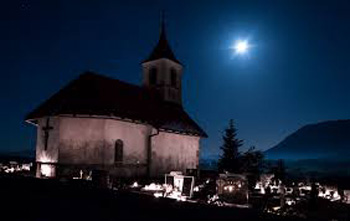
Polish & Estonian legends tell that light in the dark churches come from the souls in Purgatory visiting them
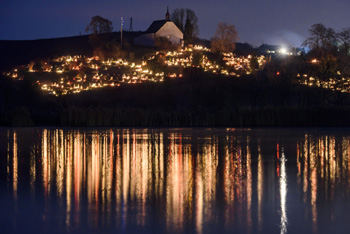
The Poles and Estonians have legends that at midnight the souls in Purgatory return to their parish churches to pray before the Blessed Sacrament. An unearthly light shines from the churches during this time.
After praying for a while, the souls are permitted to visit the places that they knew during their earthly lives. Many Central European households left their doors and windows open on this night to welcome these holy souls. (12)
A week before All Souls Day, the children in Sicily write letters to their dead ancestors. Good children who have faithfully prayed for the dead throughout the year are rewarded by their departed family members, who are said to return to earth on the eve of All Souls to hide sweets and toys for them.
In the morning the children find the gifts and make exclamations of gratitude to the dead ancestor to whom they wrote. Brightly colored candy dolls are traditional gifts left by the Holy Souls. (13)
Thus did Catholics of the past pass from the joy and grandeur of the Saints in Heaven to the suffering and sorrow of the Souls in Purgatory. Only our Holy Mother the Church can inspire such sentiments of joy and mourning in the hearts of people, inexpressible sentiments that are manifested through symbolic customs.

Sicilian All Souls Day treats
- Dom Prosper Guéranger, The Liturgical Year, vol. XV, Fitzwilliam, New Hampshire: Loreto Publications, 2013, p. 173.
- Ibid, vol. XV,, p. 58.
- http://www.brauchtumskalender.at/brauch-22-allerheiligengebaeck
- http://www.brauchtumsseiten.de/a-z/a/allerseelenspitzl/home.html
- http://www.brauchtumsseiten.de/a-z/a/allerseelenspitzl/home.html d), pp. 132-133.
- https://web.archive.org/web/20081224221901/http://www.mexconnect.com/MEX/austin/deadoct96.html
- Katherine Burton and Helmut Ripperger, Feast Day Cookbook, Catholic Authors Press, 2005, p. 133.
- https://www.thebookofdays.com/months/nov/2.htm
- Francis X Weiser, The Holyday Book, London: Staples Press Limited, p. 127-128.
- https://www.liturgicalartsjournal.com/2019/09/all-hallows-eve-halloween-in.html
- Sophie Hodorowicz Knab, Polish Customs, Traditions, and Folklore New York: Hippocrene Books, 1996, p. 225-226.
- Francis X Weiser, The Holyday Book, London: Staples Press Limited, p. 133.
- Carol Field, Celebrating Italy, New York: William Morrow and Company, 1990, p. 221-223

Posted October 28, 2021
______________________
______________________








